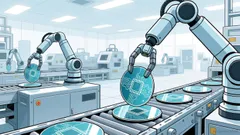AInvest Newsletter
Daily stocks & crypto headlines, free to your inbox
In a recent interview mediated by Nvidia's CEO Jensen Huang, TSMC's founder Morris Chang shared insights into his relationships and strategic decisions that shaped the semiconductor industry. Chang disclosed how he and Huang first connected through a letter that piqued his curiosity, eventually leading to a significant business partnership between TSMC and Nvidia, despite initial challenges with TSMC’s 40nm technology.
Chang talked about TSMC's pivotal decision to invest in 28nm technology, a move that secured TSMC's leadership position in the market. He focused on the strategic importance of setting research and development spending at a constant percentage of revenue, allowing TSMC the flexibility to innovate without the constant need for budget approvals. This consistent investment paid off when 28nm became a critical technology for the smartphone boom, fortifying TSMC's industry dominance.
The interview also covered TSMC's partnership with Apple, facilitated by Foxconn's Terry Gou. Chang revealed the challenges they faced when Apple wanted 20nm chips, requiring TSMC to reallocate resources and adjust timelines, which inadvertently delayed the 16nm node. Yet, TSMC managed to meet Apple's needs, ultimately benefiting from a strategic collaboration that spanned multiple cutting-edge nodes.
Chang reflected on the critical yet delicate balance required in maintaining long-term relationships with clients while navigating technological hurdles and financial constraints. His strategic foresight, particularly in the areas of research priorities and client relations, has been pivotal in transforming TSMC into a leading semiconductor foundry that partners with several tech giants like Apple, Nvidia, and Qualcomm.
Morris Chang's strategic insights underscore the delicate art of balancing innovation, client needs, and corporate strategy, solidifying TSMC's place as an indispensable player in the semiconductor landscape and illustrating the impactful relationships that sustain it.

Stay ahead with real-time Wall Street scoops.

Nov.30 2025

Nov.30 2025

Nov.29 2025

Nov.29 2025

Nov.29 2025
Daily stocks & crypto headlines, free to your inbox
Comments
No comments yet